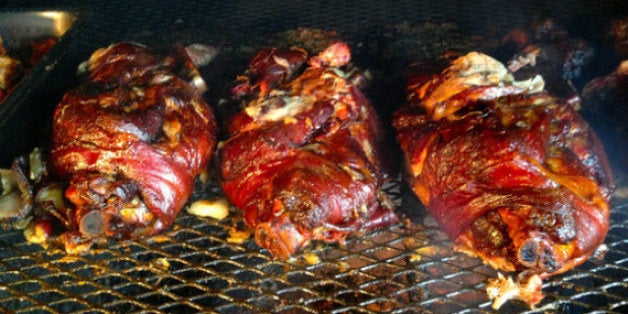
Hogs used to be bred for flavor. Today, most supermarket pork is an industrial product raised for maximum growth in minimum time so it can be sold quickly and cheaply. Even odder, the average hog today contains 31 percent less fat than it would have 20 years ago. And we all know that that fat carries flavor. So what's a 'cue fanatic to do? Well, first of all, when buying pork, choose the best marbled piece you can find. Better yet, look for a heritage breed, which is bred for flavor and fat.
Often referred to by its Japanese name, kurobuta ("black pig" literally), the Berkshire is the crown prince of hogs, with generously marbled, dark-pink, rich-tasting meat that makes supermarket pork seem downright bland. (Think of it as the Kobe beef of pork.)
Below are other examples of heritage breeds, each with its own distinct texture and flavor. Look for them at specialty butcher shops and farmers' markets. One of the trailblazers in the campaign to save heritage breeds is the Slow Food offshoot, Heritage Foods USA. On their website, they even sell pork shoulder samplers so you can compare the differences between breeds.
Red Wattle: Originally from New Caledonia in the South Pacific, this breed gets its name from its jowly appearance and rusty red color. Prized for its ham and beefy-tasting meat.
Mangalitsa: This Hungarian transplant is the antithesis of "the other white meat." Extraordinarily well-marbled, tender, flavorful meat and high-quality lard.
Tamworth: Described as "robust and gutsy" by Heritage Foods USA--in other words, porky. Because it's naturally leaner than some heritage breeds, it yields excellent bacon.
Duroc: This breed is especially prized for its shoulder meat and its spareribs. The meat is a dark reddish pink color with good intramuscular marbling (read "juicy") and high pH, meaning it retains more moisture during processing, storage, and cooking. Milder tasting than some heritage breeds.
SIGN UP for Steven Raichlen's UP IN SMOKE newsletter to learn more about barbecue!
--
Steven Raichlen is the author of the Barbecue! Bible cookbook series and the host of Primal Grill on PBS. His web site is BarbecueBible.com.